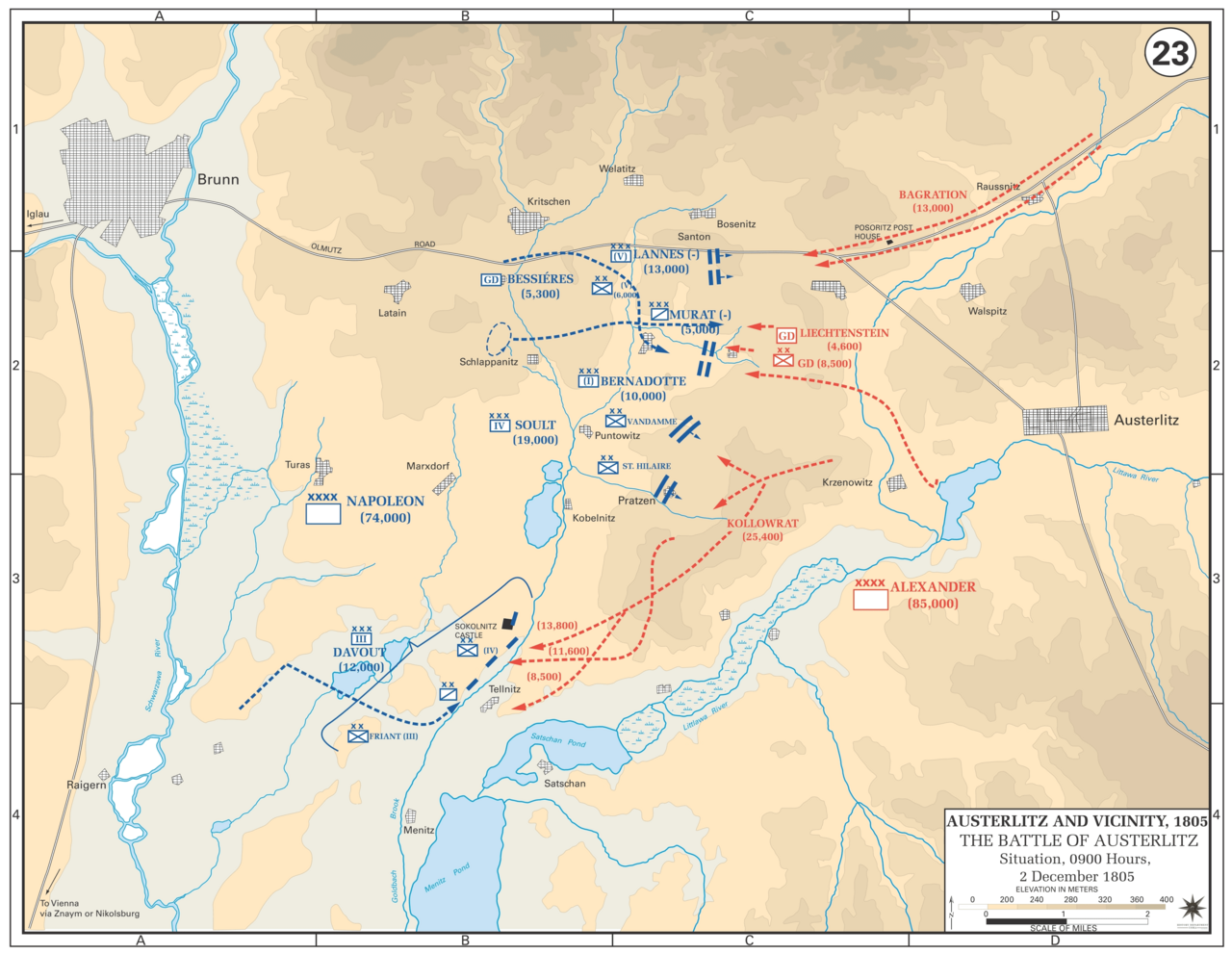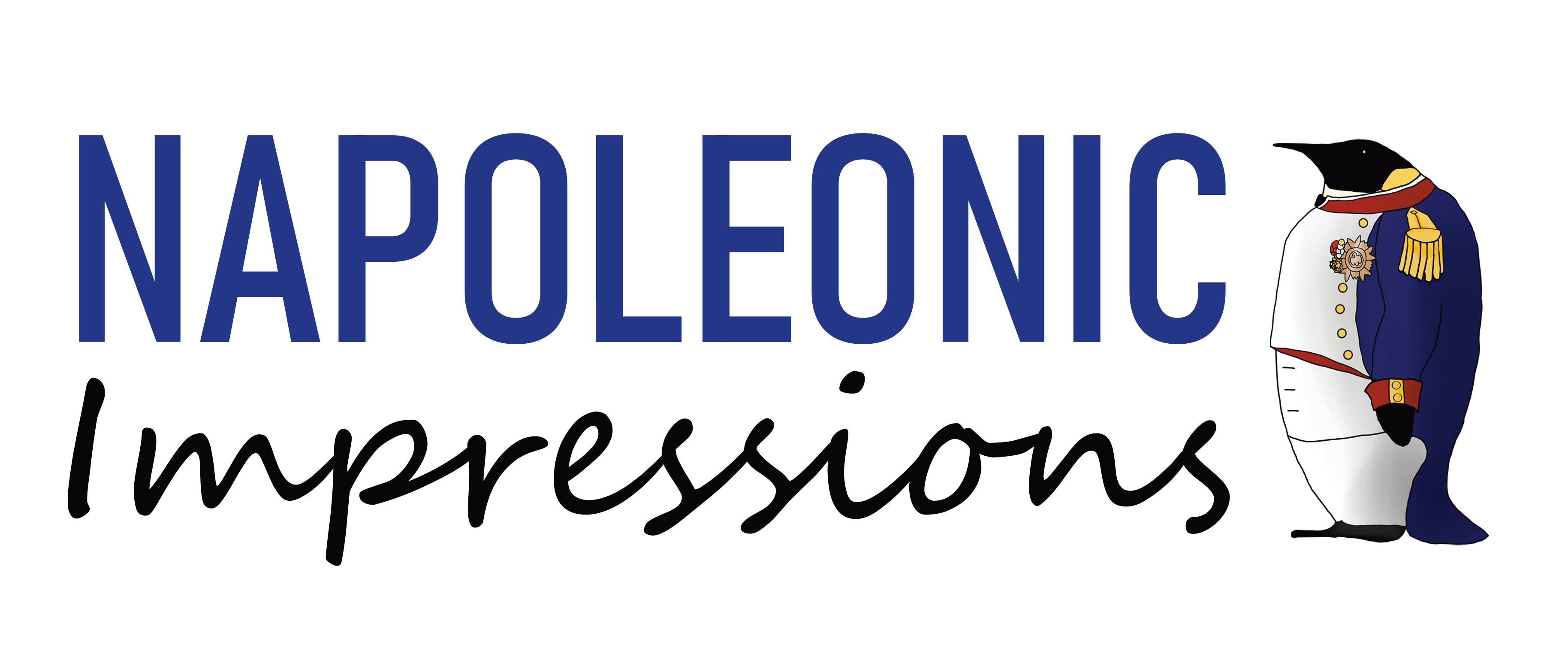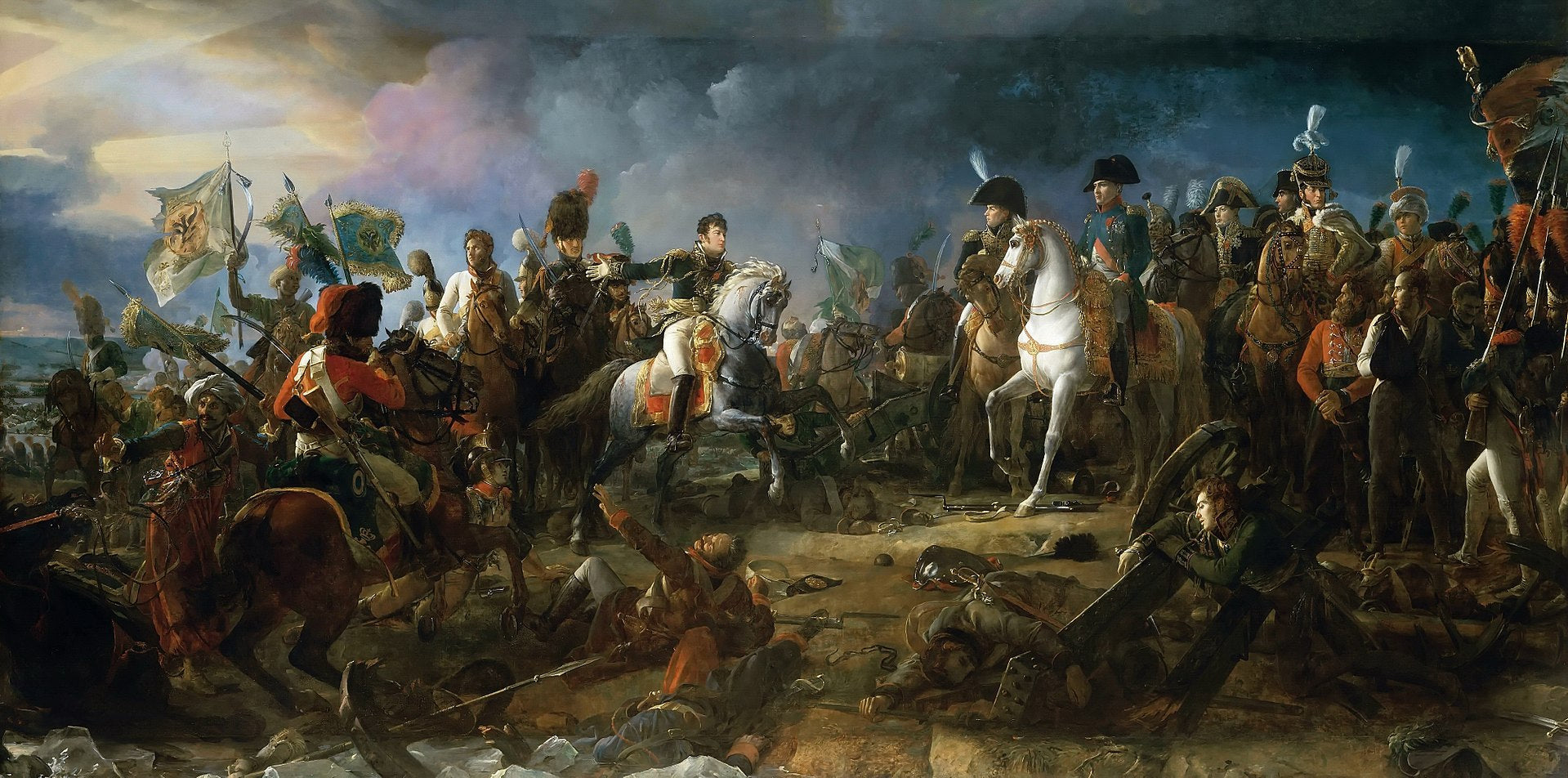This post is the second in a five part series looking at some of Napoleon’s greatest battles. To check out the rest of the series, click here. The Battle of Austerlitz in 1805 is often considered the greatest demonstration of Napoleon’s tactical genius on the battlefield: his ability to outwit his opponents, to identify the enemy’s weaknesses and exploit them with judicious use of force.
In order to tell the story of Austerlitz, we must start in 1803. After little more than a year, the Peace of Amiens between Great Britain and France had broken down and the two nations were once again at war. Bonaparte focused his energies on organising an invasion of Britain, setting up camp for a great army in Boulogne. In response, William Pitt the Younger, who returned to office as Prime Minister in 1804, sought to broker a coalition with continental European powers to distract Napoleon’s attention. Austria and Russia duly joined Britain in the Third Coalition. Prussia also took part in negotiations but decided to remain neutral for the time being.
Meanwhile, Bonaparte’s invasion plans kept encountering obstacles. Not only were the invasion craft he ordered to be built to carry his troops unsuitable for the purpose, but the French navy which was required to escort the invasion force was split and bottled up in several ports – Toulon, Rochefort, and Brest – blockaded by the Royal Navy. Although the cautious Admiral Villeneuve did eventually break the blockade and fought Nelson in vain at Trafalgar in October 1805, by then Napoleon had already lost patience. Threatened by Austrian and Russian armies mobilizing to his east, he resolved to turn his attention eastwards. At the end of August 1805, he ordered his ‘Grande Armée’ to march towards southern Germany as an Austrian army under General Mack (though nominally commanded by Archduke Ferdinand) had invaded his Bavarian ally.
The Austrians believed that Italy would be the primary theatre of the war and had sent their ablest commander, Archduke Charles, with an army of almost 100,000 men in Northern Italy. A smaller but still formidable force of 72,000 men under Mack was operating in Germany, with a force of 20,000 under Archduke John in the Tyrol to coordinate between the two armies. Russian armies under General Mikhail Kutuzov and Fyodor Buxhoeweden were marching to the Austrians’ aid, but several weeks behind. Despite his subordinates telling him otherwise, Mack believed that the Russians were right behind him, and duly launched his campaign by marching towards the Rhine.
Napoleon’s army marched eastwards with incredible speed, confounding all of Mack’s expectations. Although he had previously run rings around the Austrians during his First and Second Italian Campaigns, Napoleon now commanded an army of over 200,000 men. As in Italy, Napoleon divided his army into separate corps d’armée, each with their own infantry, cavalry and artillery units. Napoleon was not the first to come up with the idea of corps, but in 1805 he would demonstrate how best to use them. Most of his corps were under the command of one of his 18 marshals. In an operation coordinated by Marshal Louis-Alexandre Berthier, Napoleon's brilliant chief of staff, Napoleon ordered his corps to march along separate routes, widening the front but ensuring that the army would march quicker to their destination.
By the last week of September, within a month from departing from western France, these corps had arrived on the Rhine. Mack, who had established himself in the city of Ulm, anticipated Napoleon to approach from his west – the shortest route. Instead, Napoleon approached from the north, isolating Mack from his Russian allies. Even when the Austrian general realised what was happening, he believed Kutuzov’s Russians were hot on his heels, and allowed Napoleon to complete the encirclement by 15 October. Isolated units attempted to break out, but most were caught by the French, and on 20 October Mack surrendered his garrison of 27,000 men. As a result of the Ulm operation, Mack lost 50,000 men, while Napoleon suffered minimal casualties.

With ‘the unfortunate General Mack’ out of the way, Napoleon turned his attention to Kutuzov, who had been marching to Mack’s aid. Upon learning of Mack’s fate, Kutuzov retreated his advance guard of 36,000 men to get closer to his reinforcements. Over the next month, supported by the remnants of Mack’s army, Kutuzov led an impressive fighting retreat and delayed the French advance at any possible opportunity. At Schoengrabern on 16 November, Russian General Prince Bagration held off 45,000 Frenchmen with 7,000 Austrian and Russian troops, allowing Kutuzov to unite with Buxhoeweden at Olmütz (Olomouc).
In spite of his brilliant Ulm manoeuvre, Kutuzov’s escape placed Napoleon at a strategic disadvantage. He had taken Vienna in mid-November, when Murat and Lannes tricked the Austrians into surrendering a vital bridge by convincing them an armistice had been signed. However, Napoleon now faced the prospect of Prussia joining the Third Coalition, as well as Archduke Charles’s army marching north from the Alps to strike his rear. Napoleon reached the Moravian capital of Brünn (Brno) on 22 November with 55,000 men in the form of Lannes' (V) and Soult’s (IV) corps, and Murat’s reserve cavalry. Bernadotte (I Corps) and Davout (III Corps) were not far behind.
Napoleon therefore resolved to seek a battle as soon as possible, even though Kutuzov now had 90,000 men under his command. Ever the high stakes gambler, Napoleon conceived of a bold strategy to entice Kutuzov to advance against him by giving the impression that his army was in poor condition. He sent Lannes, Soult, and Murat towards Olmütz to bait Kutuzov into advancing. Although the Russian general suspected a trick, Tsar Alexander had recently arrived on the scene and was keen for the army to take the offensive. On 27 November Napoleon left Brünn to join his army, which had taken up position on the Pratzen Heights, a gently sloping hill to the southeast of the city, but which nevertheless happened to be the most prominent landform in the area. He then invited allied officers into his camp ostensibly for peace talks, who reported back to allied headquarters that the French army was in poor shape. On 1 December, Napoleon then gave Soult the seemingly bizarre order to abandon the Pratzen Heights and fall back onto the valley below, surrendering the high ground which was duly occupied by the allies.

(Soult's headquarters at Shlappanitz on the eve of the battle)
On the evening of 1 December, the allied monarchs and their senior generals held a war council to discuss battle plans for the following day. Tsar Alexander and his entourage wanted to attack, his Austrian counterpart Kaiser Francis was less keen. Austrian Chief of Staff General Weyrother was the only Austrian with offensive inclinations, and his plan was eagerly endorsed by Alexander. Weyrother planned to attack the weak French right in force and roll up the flank. The operation would be overseen by General Buxhoeweden, who was consuming vast quantities of alcohol during the meeting. Kutuzov, convinced that this would end in utter annihilation, slept for most of the meeting. The Tsar was furious at Kutuzov’s behaviour and stripped him of his command, relegating him to the command of a column. It remains unclear to this day who replaced Kutuzov as overall commander.
For all of his genius in baiting the coalition army, Napoleon’s battle plan relied on the arrival of Davout and Bernadotte’s corps, both of whom had to march at least 90km in under 36 hours to get to the field. Davout III Corps arrived from Vienna on the evening of 1-2 December and took up their positions at the village of Sokolnitz (Sokolnice) and Telnitz (Telnice) on the French right. Having endured the forced march, they would now bear the brunt of the Russian attack. Early on the morning of 2 December the allied columns streamed down the Pratzen Heights and attacked Telnitz and Sokolnitz. Displaying his genius for defensive warfare and with half his corps still recovering from the long march, Davout held back some 35,000 men with only 11,000 of his own, defended by the Goldbach stream. Sokolnitz changed hands on several occasions and eventually fell under allied control, but Davout had done his job of securing the flank. He then introduced reinforcements as needed to consolidate his position.

(The Castle at Sokolnitz)
Meanwhile in the centre Austrian General Kollowrat’s 4th column had advanced against Soult, but could make little progress against French skirmisher fire. At 8:30 Soult’s corps of 16,000 men, most of whom had been hidden by the morning mist, advanced on the relatively undefended Pratzen Heights against Kollowrat. At this moment the Sun began to burn away the mist, revealing countless ranks of French soldiers advancing on the heights. Taken by surprise to see such a large body of men coming at them, Kollowrat desperately tried to halt his men and turn them back to defend the heights. Napoleon had anticipated that Soult would be in possession of the heights within twenty minutes. It took a lot longer, but Soult eventually managed to establish himself on the Pratzen, isolating the allied columns which had advanced against Davout. Soult then turned to support Davout, crashing into the right flank of General Langeron, a French emigré in Russian service.

This was the signal for Napoleon to bring the rest of his army into action. With an inferior force on the allied right, Prince Bagration, supported by Prince Liechtenstein’s Austrian cavalry, had managed to contain a large part of Napoleon’s army, launching an audacious attack against Lannes’ V Corps. Napoleon ordered Murat to support Lannes against Bagration, who fought bravely against superior numbers but was forced back towards Olmütz with no prospect of any reinforcements. Bagration nevertheless managed to carry out an orderly retreat. Liechtenstein was cut off and went to join the Russian Guard behind the Pratzen Heights.
The allied army was now split into three parts, each prioritising its own survival. On isolated occasions Russian and Austrian commanders took the initiative as French units repositioned to continue their attack. As commander of the Russian Imperial Guard, Grand Duke Constantine, Tsar Alexander’s younger brother and heir to the Russian throne, attempted to retake the Pratzen Heights by attacking Bernadotte’s corps as it was plugging the gap left by Soult. Napoleon ordered General Vandamme to outflank Constantine, who saw an opportunity and threw his elite cavalry against Vandamme’s exposed flank, capturing the eagle of the 4th Line Regiment in the process. It was too little too late. Napoleon moved his headquarters to the Pratzen and sent his Guard cavalry, with a first charge led by Marshal Bessieres and a second by General Rapp, his senior aide-de-camp. The bloody melee between the two elite cavalry formations eventually resulted in a Russian withdrawal as the cream of the Russian nobility lay dead on the field.

(Main Battle Monument on the Pratzen Heights)
For the main allied force which had attacked Davout in the morning, the situation was dire. Completely isolated, Buxhoeweden attempted to break out against Soult but was unsuccessful and forced to surrender. In the south, General Dokhturov had executed a skillful retreat, but as his men marched across the frozen lakes Napoleon ordered his guns to fire, breaking the ice. This episode is one of the most controversial aspects of the battle and one which many detractors of Napoleon point to as a sign of Napoleon’s cruelty. Napoleon himself claimed that this resulted in thousands of allied casualties. In fact, it is unlikely that more than 200 allied men would have fallen into the frozen lakes. After the lake was drained later in the 19th century the skeletons of 130 horses were uncovered. In spite of Napoleon’s claims, Dokhturov had managed to extract most of his column.
As with all battles, casualty figures are difficult to determine with too much precision. Nevertheless, the most commonly cited figures, even if somewhat inflated in Napoleon’s favour, tell a story of a decisive victory. The Russians lost 11,000 killed and almost 10,000 captured, the Austrians 4,000 killed and 1,700 captured. In total the allies lost 180 guns. All of this was accomplished with only 1,500 men killed, 7,000 wounded, and under 600 men taken prisoner.
Following his victory over the coalition army, Napoleon and his men spent the night in the town of Austerlitz (Slavkov u Brna) some 10km to the east of the battlefield. He spent the night in the castle, which had once been the home of Wenzel Anton von Kaunitz, one of the Habsburg Empire’s greatest statesmen. On the morning of 3 December, Napoleon published his bulletin to his army:
Soldiers! I am pleased with you. On the day of Austerlitz, you lived up to all my expectations of your bravery and boldness; you have decked your eagles with a glory that shall never die. In less than four hours, an army of one hundred thousand men, commanded by the emperors of Russia and Austria, has either been cut to pieces or dispersed. Those who escaped your steel drowned in the lakes. Forty standards, the standards of the Russian imperial guard, one hundred and twenty cannon, twenty generals, more than thirty-thousand prisoners… these are the results of this day of eternal renown. This much vaunted infantry – and indeed greater in number – could not withstand your onset; from now on you have no rivals, no one to fear.
Napoleon gave orders through Berthier to continue pursuing the defeated enemy. The Austrians had had enough. Unlike their Russian allies, they had nowhere else to go. Emperor Francis sent Prince Liechtenstein to sign a truce, and on 27 December a general peace was signed at Pressburg (Bratislava), which forced the Habsburgs to relinquish their claim to parts of Germany and Italy. The following year, Emperor Francis II dissolved the 1000-year old Holy Roman Empire, fearing that Napoleon would attempt to take his place. He kept his title of Emperor of Austria, which he had established in 1804. Russia continued to fight another day, and in 1806 Prussia joined Russia in the Fourth Coalition against Napoleon. In Whitehall, upon hearing the news of Napoleon’s victory, British Prime Minister William Pitt the Younger said “roll up the map of Europe. It will not be needed for another 10 years.” Already terminally ill, Pitt would die in January 1806 at the age of 46, having served as Prime Minister for 20 of the previous 22 years.
Austerlitz is regularly cited as Napoleon’s greatest ever victory, and for good reason. Napoleon’s had demonstrated a similar modus operandi in his Italian and Egyptian campaigns, but 1805 was the first time he had done it on such a large scale, and by no means the last. The army that had been training for three years to fight the British turned on a sixpence to march against Austria and Russia at record speed. At Ulm, the army had executed a manoeuvre to perfection which eliminated an entire Austrian army with next to no bloodshed. At Austerlitz, Napoleon had successfully baited his enemy to take him on in the field and proceeded to deal them a crushing blow. Davout had held on against overwhelming numbers on the right. Lannes managed to neutralise Bagration on the French left. Soult struck an early blow in the centre to tear the allied army in half, and Napoleon himself would finish the job with his Guards. That Napoleon’s army could win at Austerlitz was testament not only to his ability to observe the course of the battle and respond when necessary, but to his confidence in his marshals, and most of all in his well-drilled men, who all delivered to a greater or lesser degree. The allies would eventually flatter Napoleon by imitating his methods and turning them against him, but between 1805-07, enjoying success upon success, Napoleon’s Grande Armée was almost unstoppable.
Thank you for reading to the end of this post. We invite you to browse our store for all sorts of fun Napoleonic products. Get 10% off your order by entering the discount code AUSTERLITZ at checkout.



Share and get 15% off!
Simply share this product on one of the following social networks and you will unlock 15% off!